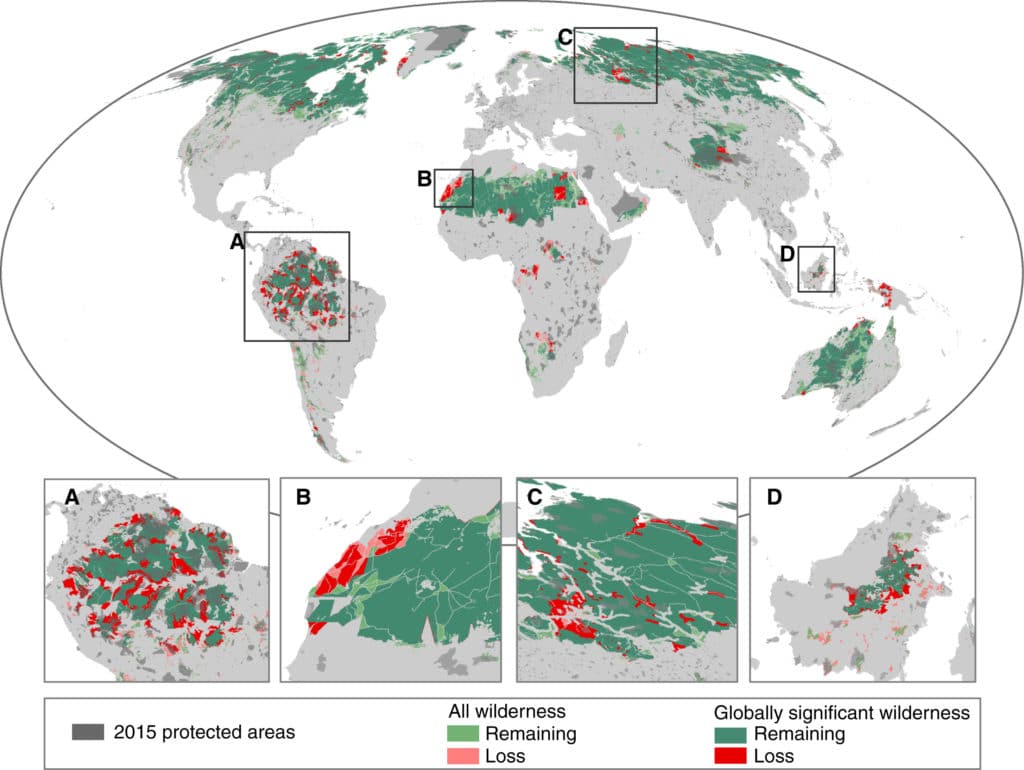We know that ever-increasing human needs is driving a concerning encroachment upon natural lands. A study published in Nature mapped the precise extent of the remaning intact wilderness and found that most of it is held by only 5 countries, upon whom a heavy responsibility now lies.
—
A thousand years ago, cropland covered less than 1% of global ice-free land, and pasture occupied an equal amount. Back then, there were 310 million humans on earth. Fast forward to 1900, and we are 1.6 billion, with farmland taking 15% of the available surface. Then followed a century of massive expansion, during which the human population multiplied by 5 and a further 16% of available land was converted for crop production.
There was a particularly extreme phase from 1993 to 2009, during which 3.3 million square kilometers (⅓ of the USA) of wild land was converted to settlements, farmland, mining and other uses.
Many studies have shown that the Earth’s ecosystems are essential for the replenishment of renewable resources like clean water and air, and that they help regulate and dampen the effects of climate change. Yet somehow, intact ecosystems are not explicitly prioritized in any international regulatory framework.
A study published in Nature assessed what is left of the world’s intact wilderness to help gauge the situation. The results demonstrate a catastrophic decline in these areas, thus emphasizing the importance of a global imperative to protect them.

Source: Watson et al. 2016. A) Amazon rainforest; B) North-west Africa; C) Russian Arctic circle; D) Kalimantan rainforest, Borneo.
The study identified Russia, Australia, Brazil, Canada and the US (Alaska) as the five nations holding the majority of the remaining wilderness. The northern Sahara, the Himalayas and the shores of Greenland also have vast stretches of untouched ecosystems spread out over multiple borders. The team also managed to highlight what has been lost since the early 1990s in red, with a particularly worrying trend in the Amazon.
What does this mean for the rest of the world?
Beyond the myriad species whose last refuge is found in these untouched havens, intact ecosystems are critical sinks for carbon dioxide. The boreal forest, spread out through Alaska, Canada and Russia, is the largest of the unbroken wilderness, and stores around a third of the planet’s terrestrial carbon. Conversely, logging and burning in the tropical counterparts accounts for up to 40% of above-ground emissions today.
Climate models also show that the integrity of these ecosystems has a strong influence on the climate. For instance, the Amazon rainforest creates gigantic atmospheric water currents by absorbing, then perspiring water multiple times from its eastern to western edges, thus regulating the weather over the majority of South America.
Protecting the last of the wilderness
It is difficult to quantify the value of a species existence, or the health benefits that arise from healthy ecosystems, and this is why strict regulation has been difficult to implement. However, carbon emissions and storage is the most readily accepted metric for climate action and legislation. The authors of the paper thus urged the attendees of the 14th UN Biodiversity Convention in 2018 to use this aspect of wilderness as a motive for mandated protection.
Explicit protection of wilderness was not achieved. Instead, an ecosystem-based adaptation was agreed upon, aiming to use ecosystem services to help fight climate change. The methods vary widely depending on the location, but an example is how healthy coral reef systems help mitigate storm surges and shore erosion in the long-term, whereas building coastal walls would simply put off the problem until the wall itself is overcome.
Aside from ecosystem-based disaster risk reduction, two big areas are also climate-smart agriculture and green infrastructure. It will take a long time for the world to establish and see the beneficial effects of nature-based solutions, yet to the best of our knowledge they are the optimal approach.
This article was written by Owen Mulhern.
References
- Watson, J. E. M. et al. Curr. Biol. 26, 2929–2934 (2016).










![The Statistics of Biodiversity Loss [2020 WWF Report]](https://u4d2z7k9.rocketcdn.me/wp-content/uploads/2020/12/lprwinkyTHB-544x306.jpg)





